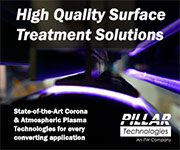Formulators Look Beyond the Peel, Tack, and Shear Profile
- Published: February 01, 2001, By Claudia Hine, Senior Editor
Although first developed more than 30 years ago, the microsphere technology behind 3M's Post-It Notes—sticky when you need them, removable when you don't—continues to drive trends in the pressure-sensitive adhesive (PSA) market.
"In the past we wanted everything to be permanent. Now we want a choice," says Ingrid Brase, marketing manager for p-s and laminating adhesives at National Starch and Chemical Co., Bridgewater, NJ.
There's more interest in ultra-removable technology today, Brase adds, because converters are pushing the envelope as far as what they expect. "You can't sell just glue anymore. It's got to be able to do something else. It's got to offer the benefit of faster line speeds or higher humidity resistance. There's certainly a trend toward using more plastic, so adhesion to low-surface-energy substrates is much more important today than it was ten years ago."
Formulators have closed the substantial gap that existed between hot melts and emulsions, reports David Anderson, technical director of product technology and innovation at Fasson Roll North America, Avery Dennison, Painesville, OH.
"When converters select material," Anderson says, "they no longer have to trade off some of the desired properties they might get from a hot melt, if they are concerned about their converting speeds. On the flip side, what we've seen with the emulsions is the formulation of a broader temperature range of application."
Anderson adds there is new, proprietary process equipment for hot melts that provides a product with improved consistency, both in performance and convertibility. "The trend in presses is wider web and faster," he says. "If we can get better converting emulsion and hot melt adhesives, either through formulation or process technology, converters won't have to increase the paper basis weight or the film grammage. It allows them to continue to use materials they're using today without having to worry about web breaks."
In certain niche applications, when an organic adhesive doesn't display the necessary resistance to environmental extremes, converters might consider a silicone PSA. There have been some advancements made in liner technology that have opened up the silicone PSA market, according to Kathleen R. Hartley, application programs development manager at GE Silicones, Waterford, NY.
"Typically, silicone PSAs were somewhat limited in their application because you couldn't release them from a silicone liner," Hartley explains. "There have been incremental improvements made in liner technology that now allow the use of a silicone release liner in conjunction with a silicone PSA. This opens up applications in the PSA area, particularly in transfer tapes and other types of assembly aids. Converters will continue to challenge us to improve the performance of our materials with better tack properties at higher temperatures. This gives them much greater flexibility—they can use a similar product for multiple applications."
Solvent-based acrylic adhesives typically are used for the trendy no-label-look labels, but there haven't been a lot of developments in that area, according to Anderson. "We are working to get more adhesive options for the no-label look than just a solvent acrylic. That's definitely something we're looking to develop."
Brase says the availability of better raw materials will spur the push toward radiation-curable technology. "By ultraviolet curing the materials, you can build better heat and chemical resistance into a hot melt than you can get using a traditional hot melt. Using a UV-curable system, we can develop formulations that will give us performance comparable to some of the solvent-based materials but not the real high-value type materials. We're working on it. That's the goal."













